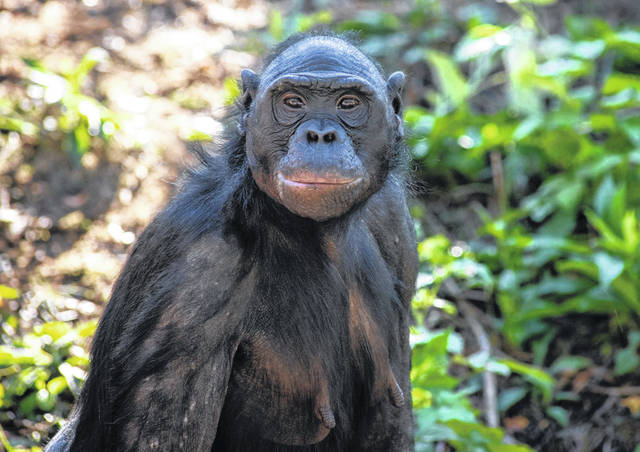
POWELL — The Columbus Zoo and Aquarium is morning the loss of Unga, a 29-year-old bonobo, who drew much-needed attention to her endangered species and touched the hearts of many around the world, including through a Broadway musical’s nod to her story.
On Friday, March 5, Unga appeared unable to move her right side, likely due to a stroke. The Animal Health team helped to stabilize her to further evaluate her. Unfortunately, her condition worsened, and she passed away. Full autopsy results won’t be received for several weeks, but initial findings through radiographs and a cardiac ultrasound showed that the walls of her heart were greatly thickened and the amount of pumped blood was significantly reduced. Those findings, along with her stroke, confirmed significant heart disease, which led to her sudden decline.
Unga had also been receiving medication, regular monitoring for her heart issues and physical therapy sessions after being treated for a stroke that affected her left side in January 2015. Thanks to the devotion of her dedicated care team, who also consulted with a physical therapist specializing in human healthcare, they worked with her five times a day until she was able to move her fingers again, hold items, raise her arm and present her left leg and bear weight on it. Even after her recovery, they continued to hold physical therapy sessions with her a couple times a week to prevent weakness from reoccurring and to reinforce the incredible, trusting bond they shared with her.
Unga was born at the Wild Animal Park Mechelen Planckendael (Royal Zoological Society of Antwerp) in Belgium on Feb. 22, 1993. She and another female bonobo, Kosana, gained notoriety when the plane that was transferring them to their new homes (the Columbus and Aquarium and the Milwaukee County Zoo) was suddenly diverted to Gander, Newfoundland, after the tragic terrorist attacks on Sept. 11, 2001.
During this unplanned, five-day layover, the people of Gander helped take great care of the bonobos and the staff who were traveling with them. Unga and Kosana’s unique story is also referenced in the Broadway musical, “Come From Away,” which tells the true story of the events in Gander when more than 30 planes were diverted there after the attacks. The Columbus Zoo team was so grateful for the community’s response in Gander that when Unga became pregnant two years later and delivered her first offspring at the Columbus Zoo in December 2003, the team named him Gander in honor of the city that had shown so much compassion. Gander, along with two of Unga’s other offspring — Jerry and Elema — are still living at the Columbus Zoo.
“From the moment that she arrived at the Zoo, I knew that Unga was a special individual. Despite all of the unexpected events she endured, Unga entered our lives with a calm and confident presence. Over the last 20 years, I have watched her grow from a playful and sassy adolescent into a strong, smart, energetic and assertive female. She was an outstanding mother and shared a strong bond with all three of her kids. She was very personable with the keeper staff and eagerly participated in training sessions that helped us manage her cardiac disease over the years, including allowing us to do the physical therapy sessions and get voluntary blood pressures. While at times her desire to be the dominant female put her at odds with the other bonobos, her presence will be greatly missed by the other members of her troop and her care team,” said Audra Meinelt, curator of the Columbus Zoo’s Congo Expedition region.
The Columbus Zoo is one of only eight facilities in North America that currently house bonobos, the last ape species to be discovered. As a result, they are widely unknown to most people. Additional research has shown that bonobos and people share more than 98% of the same DNA; in fact, bonobos and chimpanzees are more closely related genetically to humans than they are to gorillas.
Bonobos are also the rarest great ape species, with only 5,000-50,000 estimated to be living in the equatorial forests of the Democratic Republic of Congo (DRC). The International Union for Conservation of Nature and Natural Resources (IUCN) lists bonobos as endangered, primarily due to habitat destruction through logging and bush meat hunting.
The Columbus Zoo supports conservation projects working to help bonobos in their native range, specifically through Lola ya Bonobo, the world’s only sanctuary for the species. In 2013, the Columbus Zoo also awarded the organization’s founder, Claudine André, with the zoo’s inaugural Commitment to Conservation Award, which included a $50,000 grant. Claudine and her Congolese staff have rescued and cared for hundreds of bonobos and in 2010, they organized the first-ever successful reintroduction of bonobos back to their native range.
“Bonobos are incredibly fascinating, and unfortunately, they are facing serious threats in their native range. There’s still much to learn about bonobos, and we are proud to share their important story with our guests and be a part of collective efforts to help protect the future of this rare and intelligent species,” said Columbus Zoo President/CEO Tom Stalf.


